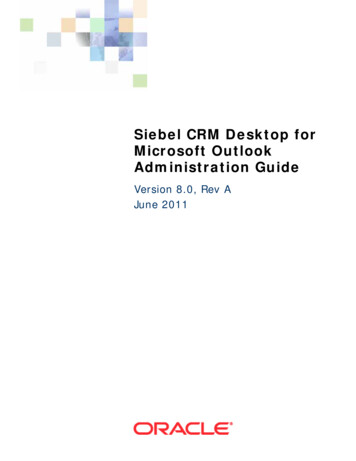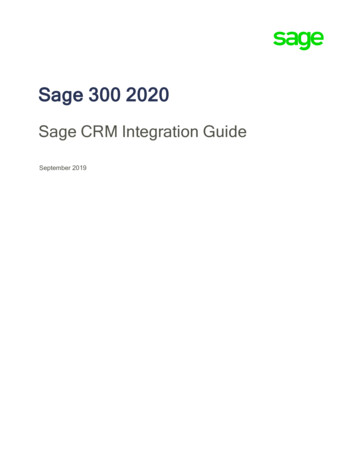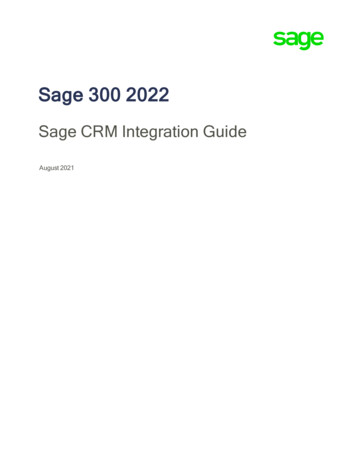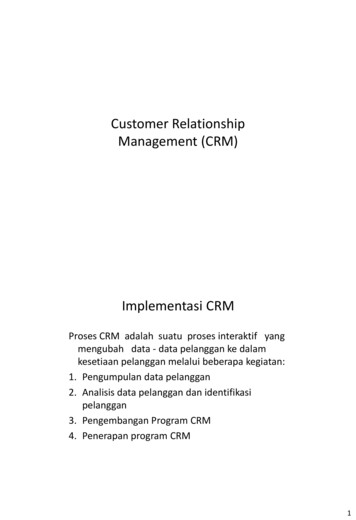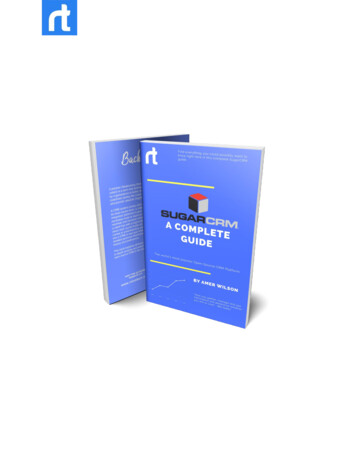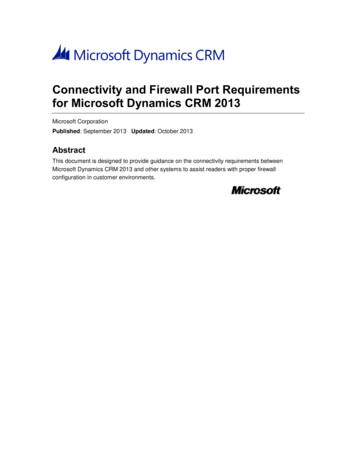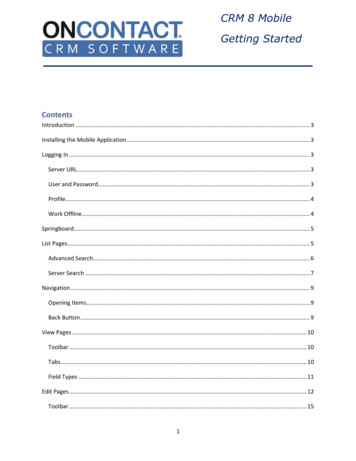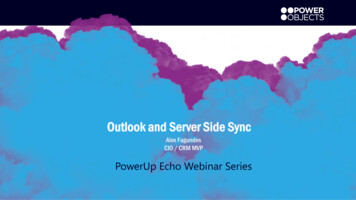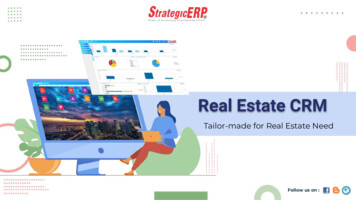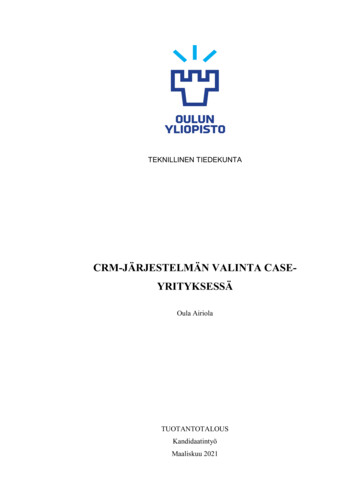
Transcription
CRM, Data Warehouses and Data Mining/AnalyticsExample:A man walks into a convenience store to pick up some diapers, at his wife’s request.While he’s there, he just happens to pick up a six-pack of soda as well. Meanwhile, backat the convenience store headquarters, a data analyst poring through data in a datawarehouse sees this and recognizes that this pairing is emerging as a pattern.Opportunity? You bet. The data analyst makes two recommendations to her marketingdepartment. First, move the diapers and the soda closer together. Second, place similaritems that men in this age group might also be inclined to purchase in between thediapers and the soda. Welcome to the world of customer relationship management, orCRM.This week your readings will explain and define Customer Relationship Management(CRM). CRM is a foundation element for business knowledge/intelligence. Your readingswill provide some examples of how CRM can be used, describe what makes it work andwho is using it, and discuss whether it has been as successful as many had hoped.Traditional CRMCC-BY by Janet Zimmer.Alternate text: relationship diagram for CRM. Center circle contains “Customer.” Three connected circlesto “Customer” contain “Sales.” Marketing,” and “Service and Support.”Customer relationship management (CRM) is a strategy used by companies to bettermanage customer relationships. CRM also goes by the name of relationshipmarketing or customer management. The definition of CRM is very broad because itincludes many facets of business-to-customer relationships. Robust CRM systems are
supported by software suites that help with the management of all the data acquired andused by the system. But the following might be considered the primary focus of any CRMsystem: providing a company's marketing department with information needed to identify andtarget the company's best customers, design effective marketing campaigns, andprovide the sales team with quality leads optimizing the information shared among departments which results in an increasednumber of sales and new accounts, better management of existing accounts, andsupporting the use of the latest communication devices (for example, allowing ordersto be made over mobile phones) improving customer satisfaction by supporting the development of individualizedrelationships with customers; might also include providing the highest level of serviceto the most profitable customers obtaining and sharing with employees the information and processes necessary forthem to effectively build relationships with their customers through understandingand identifying the customer's needs (CRM, 2006)In summary, the primary applications that are supported by a CRM are customer: acquisition—obtaining new customersretention—retaining current customersloyalty—developing customer loyalty to the company/productprofitability—increasing company profits by serving the customerservice—addressing customer inquiries and resolving issuesRelationships among CRM, Data Warehouses, and Data MiningCC-BY by Janet ZimmerAlternate text: Relationship diagram in the form of puzzle pieces. Center piece is “Data warehouse.”Pieces at all connect to the center (but separately) are “Data analysis tools,” Customer support records,”“Purchasing history,” “Customer demographic data,” and “Data mining tools.”
The example cited in the introduction is one facet of CRM—data mining customers'purchasing patterns. Data mining is the process of looking at the data stored in a company'sdatabase to determine if statistically relevant trends exist. By identifying these trends andpatterns, companies can develop strategies to better serve their customers and at the sametime increase their sales.Another example of CRM might be the evaluation of data purchased from a company thatspecializes in collecting demographic data on purchasers, including such data as location,age, gender, ethnicity, home ownership, employment status, and income level, to determinewhich individuals might have a requirement for the company’s product or services.CRM can improve services and products in other ways as well. For instance, if anorganization offers a call center that provides customer support, tracking the kind of supportthat is provided most frequently might lead to solutions that could prevent the problems fromhappening in the first place.How It Works - Data AnalyticsAlmost all CRM applications involve using a large relational database, sometimes referredto as a data warehouse. This is where the raw data about customers, products,transactions, demographics, and other information is stored. Typically, the data warehousegets its information in real time, or nearly so, from systems used to conduct transactionsbetween the company and the customer—point of sale (POS) systems, e-commerce webapplications, inventory management systems, and others.Data from the data warehouse is retrieved, organized into categories, and reviewed tosupport identification and analysis of data patterns (remember the example at the openingof this reading?). So data analytics is referred to as "qualitative and quantitative techniquesand processes used to enhance productivity and business gain" (Data analytics, n.d.) . Dataanalytics is primarily used in applications that involve the business to customer environmentand includes information about customers, business processes, market economics orpractical experience. Using complex statistical analysis software programs known as datamining tools, data analysts are able to query the data warehouse in a multitude of ways.For instance, an analyst might ask the data mining tool to retrieve from the database allpurchases made during the week of June 15 in which two specific products were purchasedtogether in stores in their East Coast region. Then, once the records are returned, theanalyst would ask the tool to show only those purchases in which a statistically relevantcorrelation between the two items existed.Sound fascinating? That is only the beginning. Consider this: Why not design the datamining tool to run specific queries such as this one on all data, once a day, and send an email to the analyst if anything interesting turns up? In other words, why not build "triggers"into the system that alert the analyst to anything that might be considered an anomaly, goodor bad? Why not have the data mining tool do all the work?By now, you have probably determined that sophisticated CRM data mining tools do justthat. Although you may have never heard of these data analysis tools (except for the one
that you are using in this class), here is a list of the most commonly used ones as providedby Vohra (2017):Open Source Analytics ToolsR- the most popular big data popular analytics tool inthe industry. It integrates very well with many BigData platforms that process and store extremelylarge data sets. Known as having a rathersteep learning curve.Python- a favorite of programmers since its releasein the early 1990s. Today it offers a comprehensivecoverage of statistical and mathematicalfunctions. Useful in the analysis phase of analytics,python can also be used as a data gathering tool onthe Internet using a technique known as 'webscraping'. Data can be extracted or gathered fromnearly any website to analyze content, but datacentric websites and social media sites are often thefocus of web scraping. The analysis phase of socialmedia data is also known as social media analytics,described below.Apache Spark – built with a focus on analytics,especially on unstructured data or huge volumes ofdataApache Storm - tool of choice for moving data orwhen the data comes in as a continuous stream. It isideal for real time analytics or stream processingPIG and HIVE - Most companies that work with BigData and leverage the Hadoop platform use Pigand/or HiveNote: "Hadoop is an open source, Java-basedprogramming framework that supports the processingand storage of extremely large data sets in adistributed computing environment. It is part ofthe Apache project sponsored by the ApacheSoftware Foundation" (Hadoop, n.d.).Commercial Analytics ToolsSAS- For a long time, the leading data analyticstool (but costly).It is robust, versatile and easy tolearn and provides specialized modules SASanalytics for IOT, SAS Anti-money Laundering,and SAS Analytics Pro for Midsize Business.Tableau- great for creating great visualizationsand dashboards. More robust in visualizations thatExcel and can handle much more data than Excelcan.Excel-most widely used analytics tool in theworld. Non-analytics professionals will usually nothave access to tools like SAS or R on theirmachines. But everyone has Excel.QlikView- another data visualization giantSplunk- great visualization options, and a webinterface makes it easy to use.CRM Is Big BusinessThere are real business benefits associated with improving customer relationships andoffering great customer service. Research shows that companies that make customerexperience a priority generate higher profits than their competitors. It is more cost effectiveto retain current customers than to attract new ones. So establishing and maintaining agood relationship with customers is critical to the financial bottom line.What are major benefits for a company that uses CRM to improve relationships with itscustomers? With CRM software, a company can track how long current customers have beenwith the company, how often they purchase from or use the company's services, andother key information. Rewarding customer loyalty does more than simply makecustomers feel good about the company; it can actually improve the company's
financial picture (What is CRM?, n.d.). Think credit cards, frequent flyer programs,special offers for loyal customers, and other rewards programs. It’s widely accepted that customers and prospective customers judge companiesbased on how well the company handles customer issues and complaints. CRM canfacilitate the handling of customer problems because CRM systems allow for a morerapid response to queries and concerns by forwarding the query to the rightdepartment. And members of each department have access to all the relevantinformation, enabling them to answer queries and resolve problems quickly andeasily. This ability to resolve complaints quickly and fairly makes a real difference tocustomers’ perceptions of the company. One study showed that more than 85percent of customers will do business or increase business with a company again ifa customer service issue is dealt with fairly. For customers who have had a negativeexperience with customer service, over 70 percent will decrease business with thatcompany or even switch companies altogether (Barbier, Noronha, & Dixit, 2013). Soit is even possible that a company may forego profits in order to address customersatisfaction first. For example, product recalls and timely fixes or productreplacements by a manufacturer might result in a loss of profitability. Beyond just thesafety considerations, however, customers who feel they have been served well bythe recall/replacement may return to the same manufacturer for their next product.Traditional CRM versus Social CRM (SCRM)The number of sales, marketing, and customer service pathways that customers are usingto communicate with companies is expanding quickly. Many customers now use a websiteor chat service to request assistance. This, coupled with increased social media usage,means that customers and potential customers are coming to businesses through more anddifferent pathways than ever before. With so many potential customers, prospectivecustomers, and competitors on the various social networks, companies must activelyengage with these platforms to stay competitive. As a result, many companies are turning toCRM systems that include social media integration (What is CRM?, n.d.), known as socialCRM, or SCRM. An article in Harvard Business Review indicates that 79 percent ofbusinesses already use or are planning to find a presence on social media sites, althoughnot all of them feel they are using such a vehicle effectively (Social Media, n.d.).Traditional CRMCC-BY by Janet ZimmerAlternate text: relationship diagram for CRM.Center circle contains “Customer.” Threeconnected circles to “Customer” contain “Sales.”Marketing,” and “Service and Support.”
In traditional CRM, there is little collaboration between the customer and the company.Marketing’s focus is on pushing messages to the customers in order to generate sales.There is definitely a service and support component, of course, which does involve thecustomer directly.Social CRMCC-BY by Janet Zimmer.Alternate text: Three layered rectangles. The innermost rectangle contains “Customer.” The next layercontains “Customer Empowerment” and “Advocacy.” The outmost rectangle contains “Sales,” “Service,”“Support,” and “Public Relations & Marketing.”In contrast, SCRM invites the customer to collaborate with the company in solving businessproblems, primarily through interaction with online social media sites. This format empowerscustomers to shape their own experiences and build customer relationships directly with thecompany. Companies such as Coca-Cola and Dell maintain their own such sites. Dellreports that customers had posted over 18,000 new product ideas and almost 100,000comments. Nearly 500 of the ideas had actually been implemented by Dell (Reynolds,2012).SCRM is a vehicle for direct and indirect advertising, as well. Some social media sitesdisplay banner ads promoting companies or services. These ads can be directed toeveryone who visits the site, or just to certain visitors who match particular demographics.Another marketing technique is the use of “fans” of a particular site, product, or company.When you “like” or “friend” a certain page on the Facebook site, for example, you are addedto a fan base which, in turn, promotes awareness about the company or product.
Participation by companies in the social media environment has resulted in a newer branchof CRM called customer experience management (CEM). Online surveys that you fill outafter purchasing products online or using services such as an airline flight feed into thecompany’s management of the customer experience. Loyalty or reward programs are also ameans of managing the customer experience. The customer is no longer a passive recipientof the company’s services but an integral part of the customer experience and relationshipdevelopment.Trends for the Future of CRMCRM and the software that supports it is not a static product. To address changes incustomer expectations, companies that use CRMs must be sensitive to the following issuesand tasks in making sure the CRM system is effective and efficient: Customers expect more. Members of Generation Y—the children of Baby Boomers,born between 1977 and 1994 and coming of age between 1998 and 2006—oftendemand the capability of interacting with a company in ways beyond the traditionalphone call. Those interaction vehicles include web chat, smartphone applications andsocial media. In fact, many customers are now reporting that the telephone is theirfourth choice when it comes to interacting with customer support (Earls, 2014). Keeping valuable staff. Front-line customer service staff at contact centers are leavingtheir positions at a growing rate. Proper CRM training, support, and state-of-the-art toolsto recruit and retain CRM staff should be the focus. Because customers are increasinglyrelying on the use of mobile devices and social media, both for communication and forsharing thoughts (including positive or negative reviews of a company, its products, andit service record), call center agents, service representatives, and sales personnel willsee a corresponding increase in duties because they are no longer answering onlytelephone calls. An agent, whether in customer service or sales, needs to know how tohandle the various means by which customers interact with the company personnel anduse the consumer's information accordingly to solve problems (Earls, 2014; McKoen,2012). Privacy. The information known about consumers gleaned from their digital interactionscontinues to grow. Users may be willing to sacrifice some privacy, such as sharingpersonal data, if they recognize the purpose or goal of that sharing. But they also expectthe data to be protected and not used for purposes other than the recognized goal.Companies need to foster a strong sense of trust in the relationship if they expectcustomers to continue to share data freely (Earls, 2014). We will address security issuesrelated to databases in the next page. Mining the social media inputs. Customers may be posting on social media sites theirhonest insights directed toward products and services. Companies pay for surveys togather this same data, which is available for free if the content can be extracted fromthese postings. Thus, social media analytics, the gathering of data from blogs andsocial media websites for analysis in order to make business decisions, is gainingimportance in businesses. These tools help marketers, sales personnel, and contactcenter agents observe customers' social output and respond accordingly to any talkabout their brand (McKoen, 2012). Cleaning up the data. Organizations need to continue investing efforts into cleaning upCRM data. Incorrect and duplicative data can add wasted time and efforts to the work of
call center or sales employees and lead to both errors and missed opportunities (Earls,2014).SummaryCustomer relationship management is a strategy used by companies to better managecustomer relationships. CRM is defined very broadly because it includes many facets ofbusiness-to-customer relationships. But the following might be considered the primary focusof any CRM system: acquisition—obtaining new customers retention—retaining current customers loyalty—developing customer loyalty to the company and/or product profitability—increasing company profits by serving the customer service—addressing customer inquiries and resolving issuesCRM is an exploding market and career field that incorporates technology, marketing, andmanagement. The applications appear to be endless in just about every major industry. It isall about data—collecting it, analyzing it, and acting on it.CRM can be used to: improve relationships with customers by locating and engaging existing and potentialcustomers, rewarding customer loyalty, and ensuring that customer issues areresolved quickly and fairly; increase revenue and referrals from existing customers; and improve products and services by gathering feedback from customers, whetherthrough surveys or social analytics (What is CRM?, n.d.).Relationships among CRM, Data Warehouses, and Data MiningData mining is the process of looking at the data stored in a company's database todetermine if statistically relevant trends exist. By identifying these trends and patterns,companies can develop strategies to better serve their customers and at the same timeincrease their sales. One example of data mining is the evaluation of data purchased from acompany that specializes in collecting demographic data to determine which individualsmight have a need for the company’s product or services.How It WorksAlmost all CRM applications involve using a large relational database, sometimes referredto as a data warehouse, where raw data about customers, products, transactions,demographics, and other information is stored. Using complex statistical analysis softwareprograms known as data mining tools, data analysts are able to query the data warehousein a multitude of ways. There are real business benefits associated with improving customerrelationships and offering great customer service. Research shows that companies thatmake customer experience a priority generate higher profits than their competitors.Because it is more cost effective to retain current customers than to attract new ones,establishing and maintaining a good relationship with customers is critical to the financialbottom line.
Social Relationship Management (SCRM)Customers and potential customers are coming to businesses through more and differentpathways than ever before, using mobile devices and social media sites instead of relyingonly on the telephone. As a result, many companies are turning to CRM systems thatinclude social media integration. This new CRM is typically called social CRM, or SCRM.To keep pace with changing customer expectations, CRMs must be sensitive to thefollowing issues and tasks in making sure the CRM system is effective and efficient. Increased customer expectations. Customers demand the capability to interactwith a company beyond the traditional phone call. Keeping valuable staff. Proper CRM training, support, and state-of-the-art tools torecruit and retain CRM staff should be the focus. An agent needs to know how tohandle the various means by which customers interact with the company personnel,and how to use the consumer's information appropriately to solve problems. Privacy. Companies need to foster a strong sense of trust in the relationship if theyexpect to continue to have customers share data freely. Mining the social media inputs. Social media analytics, the gathering of datafrom blogs and social media websites for analysis in order to make businessdecisions, is gaining importance in businesses. This process helps marketers, salespersonnel, and contact center agents observe customers' social output and respondaccordingly to any talk about their brand. Cleaning up the data. Incorrect and duplicative data can add wasted time andefforts to the work of call center or sales employees. It also can lead to errors andmissed opportunities.ReferencesBarbier, J., Noronha, A., & Dixit, A. (2013, March). Assessing the Economic Value ofMaking the Right Customer Satisfaction Decisions and the Impact of Dissatisfaction onChurn. Retrieved from Cisco: ofCustomer-Satisfaction.pdf.CRM (customer relationship management). (2006, November).Retrieved from ion/CRM.Data analytics. (n.d.). Retrieved fromTechnopedia: nalyticsEarls, A. (2014, January). Predicting the future of CRM in 2014 and beyond. Retrievedfrom Techtarget: -the-future-of-CRMin-2014-and-beyond.Hadoop. (n.d.). Retrieved from com/definition/Hadoop
McKoen, A. (2012, December 27). Top five CRM trends you should know about. Retrievedfrom Techtarget: -industry-trends#contentCompress.Reynolds, G. (2012). Ethics in Information Technology. Boston: Course Technology EngageLearning.Social media: What most companies don't know. (n.d.). Retrievedfrom insights-what-mostcompanies-brands-dont-know.What is CRM? (n.d.). Retrieved from Salesforce: http://www.salesforce.com/uk/crm/what-iscrm.jsp.
Traditional CRM CC-BY by Janet Zimmer. Alternate text: relationship diagram for CRM. Center circle contains "Customer." Three connected circles to "Customer" contain "Sales." Marketing," and "Service and Support." Customer relationship management (CRM) is a strategy used by companies to better manage customer relationships.
